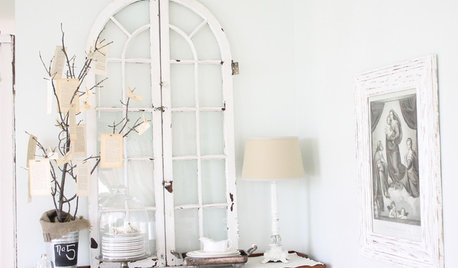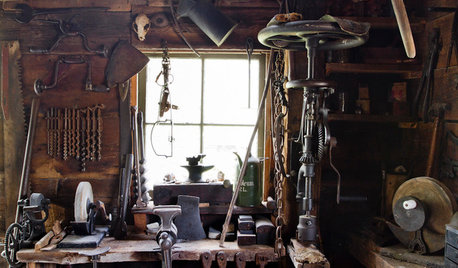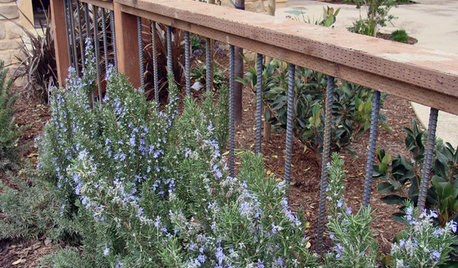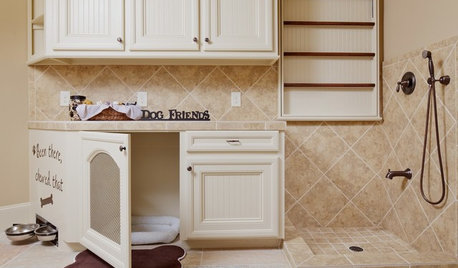Are you a Co-Potter? Companion Planter?
Do you do it? Have you tried it? Why or why not?
I'm wondering if folks out there practice co-potting, combining different kinds of houseplants long-term in the same pot. Maybe I am applying the wrong term here, so let me know O.o
If you don't do it, why not? Did you try it & have bad results? Does it fly in the face of your opinions of how houseplants should be cultivated?
Is co-potting something you've tried? Did it work out well? Do you have favorite combinations (ie: short-tall, foliage differences, color differences)? Which combos have been most successful for you?
If you've never tried it, do you have an opinion on what plants might get along best with each other? Are you like me & tempted, but lacking more info? I can imagine some neat combos that might work, but I am too chicken to try... spider plants beneath ficus or epipremnum under dracaena marginata for example... maybe it's only good for dreaming, not in practice...
I'd love to hear what you think!
Comments (21)
jonaskragebaer
13 years agolast modified: 9 years agoi dont do it, but thats just because i dont have enough space to make it look good, i only have 1 window and theres already more plants in it than there should be :/
i might wanna try it once i get a place of my own, but for now im growing them individually :)pirate_girl
13 years agolast modified: 9 years agoIt's not generally regarded as good practice for long term growing (at least less so for succulents). The main reason woudl be that these plants can have different watering requirements one from the other. The example is that what is suffucient for one of theose plants may be far too much water for the other.
I think this is referred to as community pots or group plantings.
It often happens here that folks come here to us for help with such things. It seems particularly common for group plantings to be sent to funerals. Folks then get attached to the plantings, which now represent their deceased & we wind up usually suggesting they separate the pots to individual planters & then place each of them into the larger container together.
Be brave, where's your sense of fun & experimentation?
If I had such plants I might try it w/ say a Dracena or a Spider plants w/ a Pothos underneath. Hey, actually Spider & Pothos might work OK together as neither needs frequent watering & neither wants direct sun.
Related Professionals
Danbury Landscape Architects & Landscape Designers · Clemson Landscape Architects & Landscape Designers · Hyattsville Landscape Architects & Landscape Designers · La Marque Landscape Architects & Landscape Designers · Seabrook Landscape Architects & Landscape Designers · Ashburn Landscape Contractors · Downey Landscape Contractors · Elmhurst Landscape Contractors · Pueblo West Landscape Contractors · San Antonio Landscape Contractors · Irvington Landscape Contractors · Hagerstown Interior Designers & Decorators · Ridgefield Park Interior Designers & Decorators · Shorewood Interior Designers & Decorators · Struthers Interior Designers & Decoratorsmarquest
13 years agolast modified: 9 years agoMost of my planters are group plants. I like group planting for several reasons.
-It saves on space.
-I know it seems advice is that plants grow better in their own pot but I have better success if there are group plants.
-I like the look of a garden vs a bunch of potted plants.
JMObirdsnblooms
13 years agolast modified: 9 years agoSome of my plants are potted as dish gardens. If it's done, compatible types should be potted together. In other words, never pot a cactus and Draceana or any shade-loving plant together. Combined plants should require the same amount of light and water.
Small succulents are best suited, opposed to tropicals, unless trops remain or trained small.
Dish gardens sold in stores never work. Plants need opposite care, some grow huge, and when in a basket w/plastic lining, there's a chance of root rot.
It's best making your own..less $ too. lol. TooAnd yes, combining is a space saver too. Toni
brodyjames_gw
13 years agolast modified: 9 years agoI work at a garden center that sells mixed plantings of house plants. These plants come to us already potted up from the grower, we don't combine the plants ourselves. Our combo is a mix of a dracaena, a prayer plant, a pothos (or philodendron; still have trouble telling them apart) and a sansevieria. When I bought one, I bought it for the sans. I removed the sans and pothos, potted them up separately and then replaced them with baby's tears. The grouping is doing well, as are the plants that are on their own. I also have several succulent groupings that are doing well.
It all comes down to knowing what plants have similar needs. Once you know that, then you can "design" your combo grouping with those plants that you know will work well together.Nancy
gravyboots
Original Author13 years agolast modified: 9 years agoI just love hearing so many different experiences!
Yes, it would seem a given that a successful grouping must consist of plants with similar needs & having been the recipient of pre-grouped plants, I know they are thrown together for looks, not long-term growing. I've always broken them up pretty quickly, simply because they've been potted in a plastic-lined basket w/o drainage or some such.
It seems to me that a fast potting medium might give a little more flexibility to a group planting as far as watering requirements go...
JMO, do you have plant combos that work well for you? Do you (secondarily) group based on size? color? How big are the pots you use?
I have a number of plants living with me that actually have several feet of trunk & to my eye they've always seemed a little naked down around the pot - I'm not much into tchochke ornamentation... although I do have a cute little gnome.
GB
rhizo_1 (North AL) zone 7
13 years agolast modified: 9 years agoI keep permanent plants in solitary confinement. It's the issue with the root systems, for me. I'm a proponent of occasional root pruning and re-potting (changing the potting mix), which becomes a challenge when different kinds of root systems are all growing together.
Also, it is well known that (but still little understood) that many plants fight against each other with the use of allelopathic chemicals that may hinder normal growth and development. Truthfully, plants don't make good companions for each other.
However, I'll combine all kinds of plants in my seasonal containers. My selections for these little 'gardens' will be based looks, sunlight and water requirements.
Lol, I HATE tchotchkes!
gravyboots
Original Author13 years agolast modified: 9 years agoHmmm... I'm familiar with the concept of allelopathy - or interference competition - as applied to successional ecology, but never considered it applicable to houseplants. Well! I've learned something new today!
But, I wonder: if the compounds don't build up enough in the potting medium for the "victim" to take much of them up, is that kind of competition much of an issue? Also interesting to consider is the less vigorous hormone emitter vs. the vigorous victim situation & how that might play out.
I wonder too if the typical "r-strategist" hallmarks of plenty of flowers/seeds & wide conditional tolerance would be a good indicator of what kind of close neighbor a plant might be in this situation. Although, I'm not sure how one might predict the hormonal interference potential... I think that is more of a later successional stage trait, once competition gets a little fiercer, so might be an issue with plants that are slower growers or take longer to reach maturity - thoughts?
Lots to think about, as always.... Thanks Dori & Al!
tapla (mid-Michigan, USDA z5b-6a)
13 years agolast modified: 9 years agoI'm not sure that determining whether plants would be considered r/k strategists would be of much value other than in in situ situations, or unless you might be able to determine some indication of how well r/k plants play with others based on their selection type. Parts of the maintenance required to keep group plantings humming are going to be significantly different enough to trump effects of normal r/k tendencies.
Not that it's too important, but the secondary metabolic exudates (allelochemicals) that make plants allelopathic aren't hormonal.
There is a wide variance in how much the allelopathic effects of one plant influences the way various other plants grow. One of the most commonly discussed allelopathic compounds, juglone, has significant impact on some plants, while it's influence on others is nonexistant, or easily goes unnoticed. Alkaloids and terpenes are other examples of potentially allelopathic compounds.
I think that if I had a wish to grow lots of plants in combination with others, I would probably look at allelopathy as a possibility, rather than a probability. Only after I observed a plant struggling when there is no obvious reason it should be, would I think that allelopathy might be in play.
"I think that is more of a later successional stage trait, once competition gets a little fiercer, so might be an issue with plants that are slower growers or take longer to reach maturity - thoughts?"
I don't think that either (growth) phase or competition is a factor except to the degree that we ignore the more vigorous plants and allow them to out-compete the less vigorous plants. Even if all plants in a mixed planting are growing at peak vitality, the more vigorous are going to out-compete the less vigorous.
There are many potentially limiting factors that affect a plant's ability to grow to its genetic potential. You might notice my regular use of the terms ' vigor and vitality' when I write. It is actually a plant's vitality that we hold any sway over, not its vigor. 'Vigor' is constant. Mother Nature provides every plant its own, predetermined level of vigor by programming it into each plant. Vigor is the genetic potential every plant is encoded with, and the measure of vigor is the plant's ability to resist stress and strain. Vitality, in contrast, is variable - a dynamic condition that is the measure of a plant's ability to cope with the hand it's dealt, culturally speaking. A good way to look at the difference between vigor and vitality is to look to genetics for the level of vigor and to things cultural for the plant's vitality. It's up to us to provide the cultural conditions that will ensure our plants' vitality. Vigor and vitality are distinctly different, and a good case could be made that they are unrelated, but there is no need to delve deeper into that point. A plant can be very vigorous and still be dying because of poor vitality. Far more often than not the term 'vigor' or 'vigorous' is misapplied, where in their stead the terms 'vital' or 'vitality' would have been more appropriate. Reduced vitality is what we witness when our plants are growing under stress or strain and in decline - under the effects of limiting factors. The vitality of a very vigorous plant can be negatively affected by the allelopathic influence of a much less vigorous plant.
And just for fun:
{{gwi:3287}}Al
daphne-z5
13 years agolast modified: 9 years agoA merry fee-bee to you, Al, and I raise my mug to many chk-a-dee-dee-dee returns in the spring.
Gravyboots: as far as economy of space- well, as soon as you free up more space, more plants will come home with you to fill it, right?
I use some of my larger (14-16") pots as orphanages for healthy cuttings.
My co-planting buddy is oxalis. It can really fill up the awkward spaces in a pot, fast, yet I've never seen it out-compete anything.
But the reason I'm responding is that I'm running out of room too, and have an idea I want to run by y'all: I could dig out a 6" well in some of the larger (16") pots, and rotate smaller (6") plants as underplantings.
Any thoughts or experience with this idea?
- Daphne
vlmastra
13 years agolast modified: 9 years agoDish gardens can be tailored to watering needs, but a community planting is generally a temporary situation even if watering isn't an issue since plants will tend to grow at different rates, eventually outgrow the container and their neighbors, and require repotting and dealing with entangled root systems. The plants generally chosen for such arrangements are much smaller than their mature size, e.g. areca palms, Dracaena marginata, etc., so they are bound to need drastic pruning or relocating in a year or so. They can still work of course, but they usually won't stay pretty forever.
One way to cheat is cache-potting -- just arrange a bunch of smaller pots in one large container. Any showing pots can be covered with Sphagnum, Tillandsia usneoides, peat moss, etc. It avoids the sturm und drang of ripping and repotting coplanted plants.
tapla (mid-Michigan, USDA z5b-6a)
13 years agolast modified: 9 years agoI have a somewhat different view re some of the things vlmastra mentioned. Many of you know that I have a lot of experience maintaining plants in small containers. In some cases, I have plants that have been in the same container for >10 years. To a very large degree, when plants outgrow a container, it's either because you want them to and have allowed it, or you don't know how to maintain them at a size that allows them to remain in those small containers.
Maintaining a dish garden requires pruning - period. If you're not pruning, you're not maintaining it, only helping it grow by giving it appropriate amounts of water/fertilizer/light. OK - we have a semantics issue here with the word 'maintain', but you get the point, so I hope you'll allow what I said to be true.
When you cut a plant back, to some degree you automatically prune the roots. IOW, the plant will balance the volume of fine roots with the size of the transpiring mass above the soil, and for the most part we can consider the transpiring mass to be the foliage. So, KEEPING the volume of foliage in check reduces the root volume and slows growth.
Who cares if the roots get tangled? Lift the entire soil/root mass with all 6 plants in it and go to work. Cut the plants apart and toss them in a bucket of water. One at a time, remove the soil from the roots and prune the roots. Remove mostly large roots if you can, but in many cases you can remove up to 90% of the root mass of a plant and it will recover quickly. Remember, houseplants are houseplants because they are sturdy and tolerate a LOT. At that time, you reduce the top of the plants by cutting back.
You guys have seen the thread where I showed the pictures of the China Doll and asparagus fern being reduced several times? That planting was just (top) reduced again this fall for the 4th or 5th time. It's been in the same dish for about 8 years and has not been repotted. I reduce the top, the roots that are unneeded are shed by the plant and break down in the soil, and the beat goes on.
Eventually, I'm going to have to root prune and repot that planting, but after I do that, I'll probably give it away so someone else can enjoy it. To be fair, the fact that the plant is in the gritty mix is a major reason the planting was/is able to go so long between repots. Combine such a durable soil with regular top maintenance, and your dish gardens can look good for years and years. Without batting an eye, I can honestly say I could EASILY maintain the same 2 China Doll trees and the same 2 asparagus ferns (plumosa) in that shallow dish tray for 20 years. All that's required is proper maintenance.
As I noted above (I think) when it comes to plants possessed of greater vigor than others overtaking/out-competing the less vigorous plants, it's up to you to keep that from happening. There is nothing stopping you from taking a razor knife and cutting the more vigorous plant out of your dish garden, reducing it by pruning roots and cutting it back, and returning it to the dish. You also have the option of starting a cutting long before you intend to reduce or remove the plant and replacing the more vigorous plant with a clone of itself, or replacing it with another plant entirely.
Many of the people that come here for the first time, and even some regulars, operate under the assumption that when you bring houseplants home they will inevitably decline and in a few years you'll toss/replace them. I call that the revolving door mentality .... bring one in - take one out; but it's only that way because the plants are not being maintained in a way that ensures their vitality.
I have a dear, dear 97 year old friend I've written about often, who lies today in the hospital and confides he's 'on his way out' (please offer a prayer for him if you can). I wrote a little something about him that didn't get much attention and posted it to this forum. In it, I told the story he told me about giving away a 100 (not a typo) year old fern. Most of us can't even imagine keeping a plant in a container for that long, but with the proper maintenance ......
What if I told you you can maintain succulents and Impatiens in the same dish garden or companion pot and both plants would be happy? If anyone doubts, be ready to wager. ;o) What limits our ability to combine a wide variety of plant genera in the same pot? The answer is 'the soil'. The heavier the soil is, the more critical it is that you only combine plants that tolerate wet feet in the same container. A huge % of plants suffer from heavy soils and wet feet. Even if you can't see the damage, there is always lots potential in soils that have the inherent problem of supporting a layer of saturated soil at the bottom of the pot. This kills roots - period. It doesn't kill ALL roots; it starts with the finest roots first - the tiny feeder roots that absorb water and nutrients. Every time we water, and often when we only water in sips, the water 'pools' in the soil at the bottom of the pot and roots their die back to varying degrees. This causes tow things - either root rot, or the tendency for plants that tolerate these wet conditions better to quickly out-compete their stressed or strained companions.
As the soil moves toward better aeration/ better drainage, a much wider variety of genera will grow happily, side by side in a soil that is never soggy, only damp. In soils like these, it's possible to grow an impatiens and other plants that tolerate wet feet (though don't necessarily APPRECIATE the condition, alongside other plants that prefer a moist or evenly moist soil. Before we argue the point that succulents do/don't like 'evenly moist' soil, you should consider the fact that you might imagine that directions to allow the soil to dry down (for succulents) before watering again is a good way to help you help your plants that suffer more from saturated soils to recover before the next deluge.
Cache-potting will work, but relying on root constriction to keep plants small has it's drawbacks. Loss of foliage, the 'tufted look', which is when foliage appears primarily at the end of branches (on plants that branch), lack of extension, reduced vitality .... are some of the things that accompany root restriction. Once the plant gets root-bound, you still need to go through the same procedures you would need to undertake to maintain the plant if it was growing in a dish garden or just cohabitation with other like-minded plants. ;o)
Al
vlmastra
13 years agolast modified: 9 years agoHi Tapla, some very good points. You certainly have more experience than I in coplanting. I will say that I'm not a big pruner, and I repot my plants only when they are ridiculously potbound. But your method certainly works out! Your container gardens are gorgeous! Different people, different methods.
An addendum: I am by no means of the opinion that houseplants are a temporary affair. I've seen and read about enough heirloom plants to know better. I even have a few that are about as old as my houseplant hobby. Only maybe 5 or 6 years, but still! Holiday cacti are certainly good that way, Encyclia cochleata, Hoya carnosa, Aloe vera, etc. as well. Actually I'm now recovering some Hoya carnosa from mealy bugs and a half-year bout of no watering (long story involving me moving away from home). I recently acquired some Phlebodium aureum which is probably the most dry-tolerant fern I have ever witnessed. Many of the old favorite houseplants are unbelievably resilient. I don't post here often, but I'm certainly not new to indoor gardening. :)
I'll have to check out this China Doll thread. I have a friend that in ~2 years raised one from a 3" pant from Target in a tiny pot to a gorgeously monstrous 6 footer in a 2 gallon pot. She is wonderful with plants. They are very thirsty and (at least for her) extraordinarily prone to spider mites. She does have an issue with pruning aversion, LOL.
tapla (mid-Michigan, USDA z5b-6a)
13 years agolast modified: 9 years agoOh please - ;o) I never meant to imply that anyone in particular had a revolving door mentality - just that it's out there. .... really sorry if you got that impression. You know, it's not surprising that so few people really know how to maintain plantings, and especially mixed plantings, for the long term. Nearly 100% of the book and net sources keep talking about potting up, potting up ..... but fortunately, I'm in a position to borrow extensively from many years of experience as a bonsai practitioner and apply it to other forms of container culture. I can say unequivocally that potting up ensures our plants will never be able to grow to their genetic potential within the limiting effects of other cultural influences, while repotting and root pruning ensures they CAN have the potential within those same limiting factors. Unfortunately, a very few have criticized me, suggesting that because I do practice bonsai, some of the techniques I share only apply to that discipline. This is an uninformed assumption (not talking about you). I would guess that at least 90% of what I know about plants applies to ALL plants. Only about 10% of it is plant-specific or bonsai-specific, which means I have a lot to share that isn't very commonly known within the houseplant community but is readily and easily adaptable to all containerized plants.
I'm very pleased to have made your acquaintance, Deanna. Merry Christmas. The house is quiet, the kids have returned to their homes, and I'm ready to retire. ;o)
Al
gravyboots
Original Author13 years agolast modified: 9 years agoNaughty Me, abandoning a thread ;)
Happy New Year everyone & I hope all had a wonderful holiday!Al, thanks for the allelochemical info. What you're saying - that if vitality is suffering for no apparent reason, consider chemical competition - makes sense.... as does the r/k compatibility being regulated by aggressive (to many ways of thinking; standard to yours!) maintenance. However, I do think that traits such as wide tolerances & early maturity vs. "pickiness" & slower growth will give one somewhat of an indication of what they're in for, maintenance-wise.
I am currently stewarding some plants that will be left in this now-vacant (except for me!) house-share when room-mates move in & I move out... and trying to develop a strategy for them that will all but ensure happiness & health for the plants, as well as be aesthetically pleasing for their humans. (This forum has been a great resource for compiling care instructions - thanks!!) I know I'll still have to come over to fuss with the plants occasionally. Maybe I'm a little weird, but I really do like those office lobby groupings of low crawlers & taller trees!
An aside about the "revolving door" mentality: I've had a certain wax begonia for 20 years - evidence that even the most "disposable" bedding plants can enjoy long, long lives! Also, my P. scandens came to me from the 85 year-old aunt of a neighbor 20 years ago; I have no idea how old it might be... Although I've had my share of fatalities, I am constantly amazed by the long survivorship of the majority of my leafy friends.
marquest
13 years agolast modified: 9 years ago"Maybe I'm a little weird, but I really do like those office lobby groupings of low crawlers & taller trees!"
gravyboots, You are not weird. or Maybe we are both weird. That is why I started group plants. When you go to the mall the group plants look so pretty. It reminds me of a beautiful garden.
I do not just grow plants they are part of my home decor so I want them to look good. I also buy pretty pots to coordinate with the decor of the room they are growing.
tapla (mid-Michigan, USDA z5b-6a)
13 years agolast modified: 9 years agoThere are some statements that can be broadly applied and some that can't (the tricky part is knowing enough to determine which is which) ;o), but one that CAN be broadly applied is. 'If you're maintaining plants whose age is measured in decades instead of months, you're definitely doing something right - especially if they still look good. If someone is here looking for help because of a problem, there are areas that need work. That's not a bad thing, it just 'is'.
We're charged with the responsibility of maintaining plants that live long lives in nature, and from the evidence presented, we know they CAN live a long and healthy life as houseplants. In fact, if you weigh our watchful eye against herbivorous predators in the sun room, insect marauders, disease, and other forms of pestilence against the idea that survival of the fittest is about the best thing a plant can hope for in the wild, houseplants should have the potential to live even longer than their wild counterparts - unless/until grower error becomes a limiting factor.
Bonsai trees are just plants. Many of them the same trees commonly grown as houseplants, so let's not encumber ourselves or get bogged down by the idea that 'bonsai' plants, by some act of magic, are endowed with super-longevity ..... they aren't. Their longevity is something attributable only to the quality of their care. In many cases, they actually have the potential to have their lifespans measured in even number multiples (2-3-4-5X) of their wild counterparts. The same is true of houseplants, yet precious few have plants, healthy plants, older than a few years.
"Al - what you're saying - that if vitality is suffering for no apparent reason, consider chemical competition."
Yes, in group planting consider it, but sometimes you need to depend on understanding several possible causes that are not apparent. While we consider allelopathy, we might ignore that plant A has trouble taking up iron in a soil with a pH that plant B prefers. How do we determine then if it's a nutritional deficiency, a pH issue, or allelopathy at work?
We sometimes need to be pretty good detectives to keep our plants on track and to fix them when they're broke. Not everyone has the skill set to feel comfortable diagnosing problems, and some that DO feel comfortable still are lacking, especially when they don't know where their limits lie. Rather than fuss & fret about fixing a plant when it's stressed and declining, it makes far better sense to make the cultural conditions that affect the plant as close to perfect as possible. This allows the plant to grow at much closer to peak vitality and keeps the plant in a state where it can do its own fighting w/o our help.
The most important part is to start with a good soil. I can't stress enough how important that is. Once you have a quality soil to work with, settling on a good nutritional supplementation program and learning good watering habits pretty much completes the important learning. After that, if you give the plant the light and temperature it needs, I promise you'll have eliminated a huge % of the problems hobby growers most often inquire about.
Al
scpearson
13 years agolast modified: 9 years agoHello Everyone,
I am a co-potter! I particularly like to mix asparagus fern with ivy and other plants such as inch plant. I have one hanging that is about 6 feet long, 2 years old, and it is a pretty mix. The various types of ivy with asparagus mix also seems to do well together. I have several of those mixes.
This year I mixed a spider plant with some type of airy fern that seems to be doing well together. I also have some ivy mixed in with a spider plant that has done exceptionally well together. I have never mixed pothos with anything, but after reading other posts, I think I'll try that next. I am a philosophical gardener who believes if they don't belong together, they won't survive (and sometimes they don't) and so I just try something different next time.
Susan (NE CT)gravyboots
Original Author13 years agolast modified: 9 years agoSusan, your vine mixes sound pretty - we'd love to see pictures if you're so inclined!
jodik_gw
13 years agolast modified: 9 years agoI, myself, like little mixed dish gardens or terrariums, but I'm careful to choose plants that prefer the same kinds of conditions.
At present, I don't have any indoor mixed plantings... but come spring, I'll have several mixed plantings outdoors.


















tapla (mid-Michigan, USDA z5b-6a)